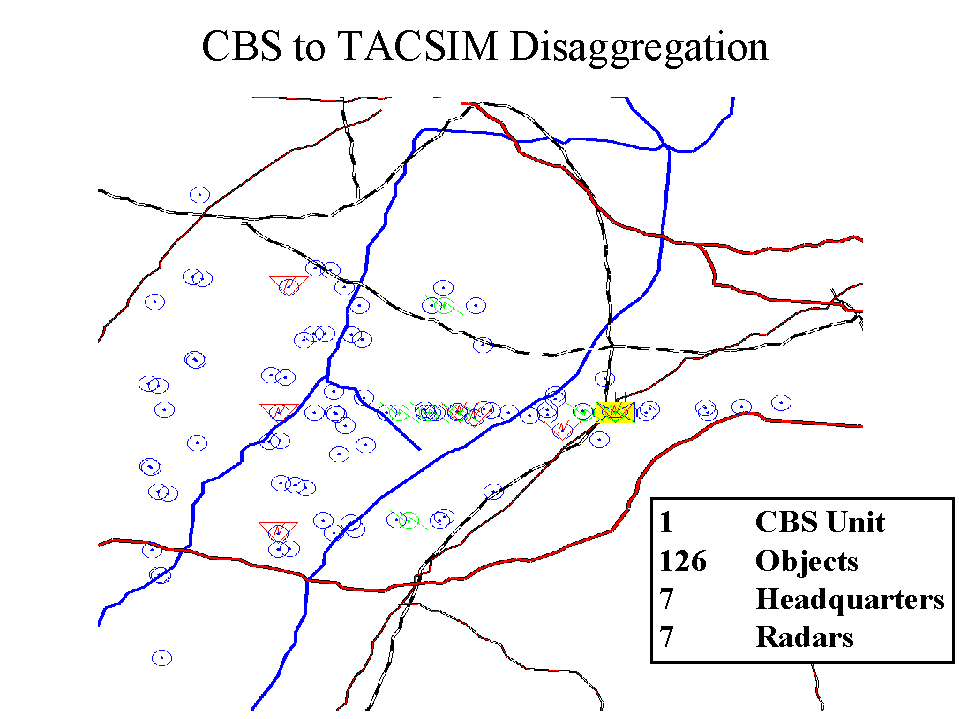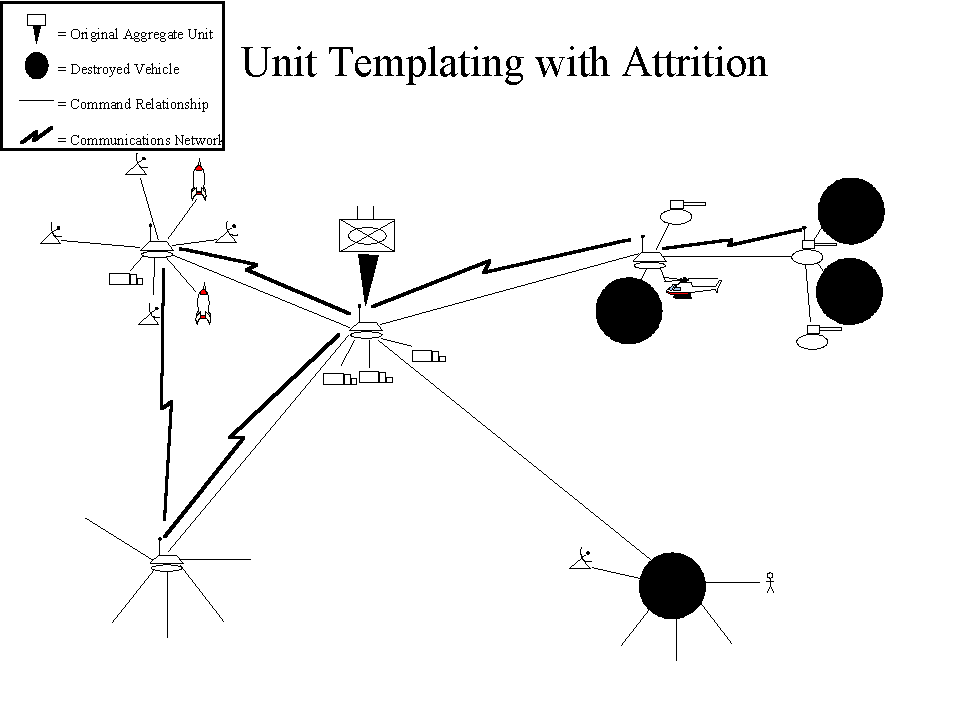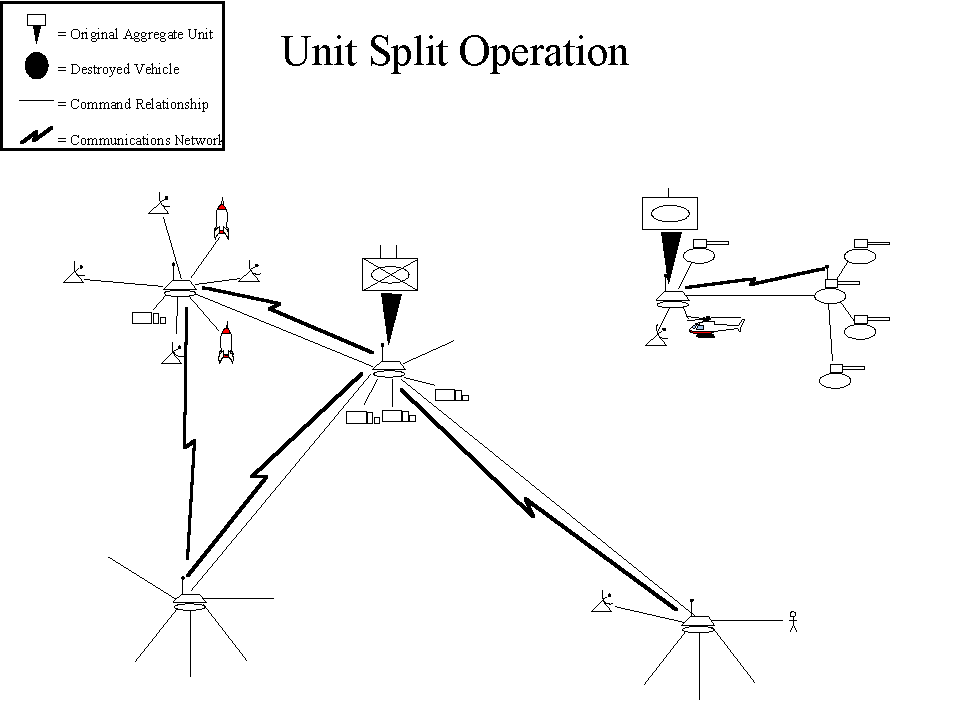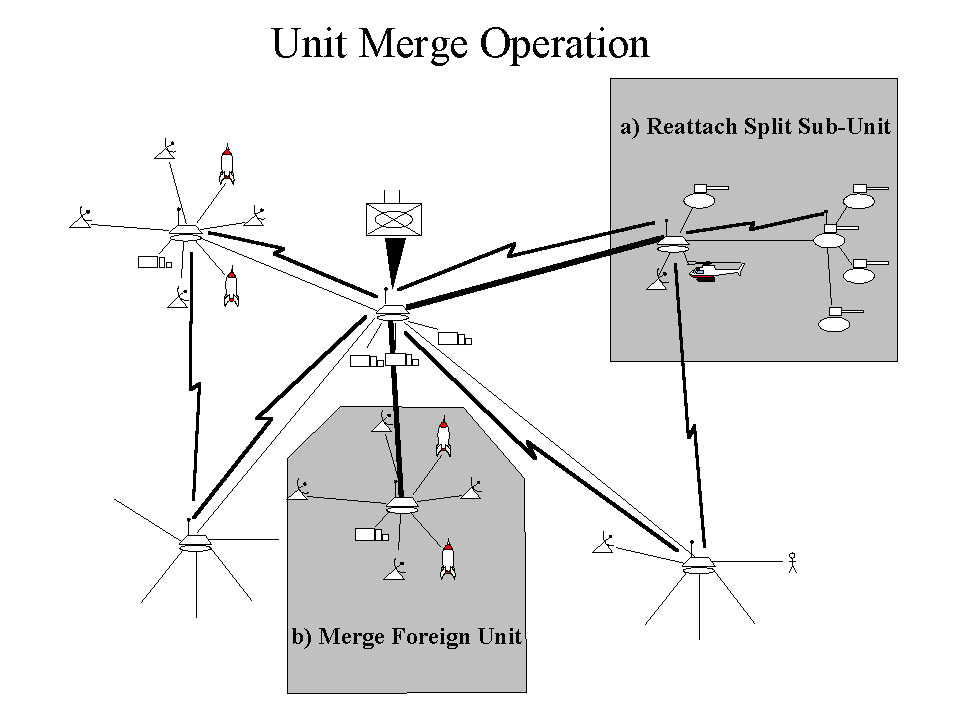
Figure 1. CBS-TACSIM Disaggregation Example
Disaggregation of units from constructive training simulations to support interoperability with entity level simulators has been tried on several projects. The results have been a limited degree of interoperability between specific simulations, but have not produced the universal interoperability needed by the next generation of simulation systems.
This paper describes the techniques used and degrees of success achieved
by various disaggregation techniques in support of intelligence training.
Both the Corps Battle Simulation (CBS) and the Joint Conflict Model (JCM)
have been integrated with the Tactical Intelligence Simulation (TACSIM)
and the Federation of Intelligence, Reconnaissance, Exploitation, Surveillance
and Targeting Operations Models (FIRESTORM) to provide intelligence activities
for aggregate level command and staff training. Both TACSIM and FIRESTORM
require individual vehicle representation for sensor collection and real
world United States Message Text Format (USMTF) report generation. To support
these, several techniques have been developed and fielded to Army and Joint
exercises. These techniques are captured in this paper to ensure that the
lessons learned in this area are available to the future intelligence simulations
in support of the Joint Simulation System (JSIMS). JSIMS intelligence simulations
currently include the WARSIM Intelligence Module (WIM), National Simulation
System (NATSIM), and the JSIMS Signals Intelligence Simulation (J-SIGSIM).
Roger Smith is a Technical Director for Mystech Associates. He is actively involved in designing, developing, and fielding simulations, having contributed to JSIMS, WARSIM, J-SIGSIM, TACSIM, AWSIM, ALBAM, and others. He is very active in the simulation industry serving as the Chairman for the ACM Special Interest Group on Simulation, the General Chairman for the Electronic Conference on Training Simulation, and as a member of the editorial boards of ACM Transactions on Modeling and Computer Simulation and the International Journal of Computer Simulation, Modeling, and Analysis. He is an Adjunct Professor in the Graduate School of the Florida Institute of Technology where he teaches discrete event and training simulation. His research interests include embedded simulations in operational equipment, integrated simulation-C4I systems, and problems in aggregation/disaggregation.
BACKGROUND
The US military trains commanders and staffs with constructive simulations like the Corps Battle Simulation (CBS) and Joint Conflict Model (JCM). But the corresponding intelligence operations must be represented at the entity level to provide accurate sensor detection and reporting of targets. The intelligence community involved in these training events receives data about individual vehicles and generates United States Message Text Format (USMTF) messages to communicate this information to the combat commanders. Sensor detection can not be accurately portrayed against aggregated targets, nor is real intelligence data generated at that level. To support this combination of aggregate and entity level data the Tactical Simulation System (TACSIM) and Federation of Intelligence, Reconnaissance, Exploitation, Surveillance and Targeting Operations Models (FIRESTORM) simulations have both explored techniques for disaggregation that have been very successful in military training exercises.
Operations
The size of a training scenario is closely related to the level of control of the unit being trained. A Company can be trained by replicating the immediate area surrounding its physical location - a few hundred square kilometers containing military objects numbering in the low hundreds. A Corps, on the other hand, operates over an area the size of a country, many thousands of square kilometers, containing tens or hundreds of thousands of military objects. Bridging this huge gap to allow company and corps training to take place in the same simulated environment and using some of the same tools is a significant challenge.
The primary simulation for conducting corps level training is the CBS, a constructive, aggregate simulation scoped to handle up to 20,000 units in a single exercise. The number of objects within these units is not limited since they are aggregated members of the larger units. The 1996 Prairie Warrior exercise included as many as 700,000 objects within 20,000 constructed units. Participating in this size of exercise through the use of traditional disaggregation methods is challenging.
If full virtual disaggregation were attempted with the size of scenario described above it would require a very large number of Semi-Automated Forces (SAF) computers to manage. The Modular Semi-Automated Forces (ModSAF) system is scaled to handle 100 objects before reaching the limits of its computer host and human operator. Controlling a Prairie Warrior exercise would require at least 7,000 ModSAF computer suites and operators. The Simulator Networking (SIMNET) SAF system is scaled at 60 objects and would require up to 11,666 computer suites and some larger number of operators. The Close Combat Tactical Trainer (CCTT) SAF is scaled at 861 objects and would require at least 813 suites of equipment and operators to manage the exercise. At the furthest extreme, operating 700,000 objects with virtual simulators would require 700,000 suites of computers and upward of 2 million operators and controllers (Table 1).
Table 1. System Requirements for a Prairie Warrior Exercise
| System | Objects / Hardware Suite | Hardware Suites | Human Operators |
| CBS | 700,000 | 1 | 400 |
| TACSIM | 350,000 | 1 | 50 |
| SIMNET SAF | 60 | 11,666 | >11,666 |
| ModSAF | 100 | 7,000 | 7,000 |
| CCTT SAF | 861 | 813 | 813 |
| CATT Level | 1 | 700,000 | > 2,000,000 |
Intelligence Training and C4I Connectivity
The intelligence federate of many corps level exercises is the TACSIM. This constructive, entity level simulation is scoped to handle up to 10,000 units in a single exercise. It accepts the combat information of the Opposing Forces units, and provides intelligence training to Blue intelligence brigades and other staff organizations. However, operating at the entity level results in the significant challenge of disaggregating 10,000 units to as many as 350,000 objects. The technique used by TACSIM is commonly referred to as "pseudo disaggregation".
The TACSIM project has wrestled with the problem of managing entity level information and simulation calculations as a member of a constructive, aggregate training federation. It has long had a dedicated interface to CBS and more recently has been a member of the Aggregate Level Simulation Protocol (ALSP) Federation, which includes the:
TACSIM is also unique in that it delivers all simulated intelligence reports directly to real-world C4I systems via tactical communications networks. These networks and processing equipment vary in age and capabilities, but represent a serious limitation in the ability to disseminate simulated information directly into tactical equipment. This limitation has caused the developers of the system to evaluate the amount and level-of-detail of information that must actually be passed to the training audience.
CURRENT TECHNIQUES
The current method of disaggregation is focused on providing unique locations for individual pieces of equipment even though the original unit reported from CBS is a single aggregated position. Intelligence analysts require the doctrinal positioning of vehicles, radar, and radios to infer the type, size, activity, and intention of the enemy unit. The level of detail of these locations is less important than the relative positioning to other equipment in the unit and the operations of the equipment. As a result, TACSIM has used a form of branch-and-node templates to distribute the equipment in a unit controlled by CBS. Since control resides within the CBS system, TACSIM must add detail to the synthetic environment without changing the basic information received from CBS. To illustrate the complexity of these templates, an actual exercise example is shown in Figure 1. A single unit name, location, and activity are received from CBS (the motorized rifle regiment icon in the figure). This unit contains 126 objects to be disaggregated, seven of which are headquarters objects, and seven radar emitters.

Figure 1. CBS-TACSIM Disaggregation Example
Deployment
Deployment templates provide specific locations for each piece of equipment within the unit. These templates form a static latticework which is applied to a unit according to its type, size, and activity. A unique template must exist for each combination of these three characteristics (Table 2). The templates must also match the equipment lists associated with a unit in CBS. TACSIM uses the internal headquarters vehicles as control branches for creating subordinate units. A battalion may contain four company headquarters vehicles and three platoon headquarters for each company. These relationships are maintained through the disaggregation process. The maintenance of this command structure is helpful in determining the organization and ownership of individual pieces of equipment and supporting combat events experienced by the unit and its equipment.
Table 2. Template Indexing Concept
| Type | Size | Activity | Template ID |
| Armor | Army | Attack | A1 |
| Motorized Rifle | Corps | Defend | B2 |
| Infantry | Brigade | Convoy | C3 |
| Air Defense | Regiment | River Crossing | D4 |
| Anti-Tank | Battalion | Assembly | E5 |
| etc. | Battery | etc. | etc. |
| . | Company | . | . |
| . | Platoon | . | . |
Modifications
If military units were limited to unhindered movement around the battlefield it would be a simple matter of moving the templated unit from place to place to maintain its status and position. However, the units have a tendency to engage in combat events that result in the destruction and partial damage of equipment and the split, merge, and reorganization into new kinds of units. CBS reports this information to TACSIM which must determine which pieces of equipment to apply the modifications to. In CBS, each equipment type is uniquely identified, but in TACSIM each equipment item is identified. Therefore, TACSIM randomly selects an item of the equipment type to be destroyed or damaged in response to a message from CBS. Equipment destruction results in the removal of a node from the branch-and-node template (Figure 2). That piece of equipment will no longer be available for collection by intelligence sensors. However, if the equipment is merely damaged it will continue to appear to the sensors as a damaged piece of equipment.

Figure 2. Unit Template with Vehicle Attrition
Other modifications to the unit include split, merge, and task organize operations. A unit is able to split into two pieces along unit/sub-unit boundaries. For example, a battalion is able to split off an independent company sized unit (Figure 3). Both units then have unique instantiations and engage in events independently of one another. Multiple splits can result in the complete decomposition of a battalion into independent companies. As this occurs TACSIM instantiates a new template for the sub-unit. This instantiation is taken from the sub-unit branch of the branch-and-node template of the original unit. This dynamic template creation avoids the necessity of pre-defining templates for every sub-unit that could be created during an exercise. It also eliminates the problem of searching for the sub-unit template to be applied to a unit when a split occurs.

Figure 3. Unit Split Operation
Two units are also allowed to merge together and form a single unit. In many cases this operation is used to reverse a split operation that has occurred in the past. A large unit may break into smaller units to infiltrate enemy lines, but then reassemble to conduct a mission behind those enemy lines. When this type of merge occurs the templates simply reattach the sub-unit to the same position in the latticework that it was removed from. This allows the unit to become exactly the unit it was before the split occurred (Figure 4a).
Though the above is the most common, there is no requirement that merging be limited to this instance. Any two units may be merged together regardless of past association. When this occurs, the two units' command centers are aligned and the resulting template is a union of the templates of the original units (Figure 4b). This form of merging results in a deployment pattern for the unit that is not doctrinally correct. However, no means of creating original patterns has been found within the computational limitations of the TACSIM system.

Figure 4. Unit Performing Merge Operations
Task organization is the process of creating a unit from parts of several other units. The intent is to create a new unit that is custom built for a specific mission. This operation is carried out through the combination of several split and merge operations as described above. The same rules apply and the probability of creating a doctrinally correct deployment for a task organization is low. However, as with real task organized units, the intelligence fingerprint collected by sensors is difficult for an analyst to interpret.
Limitations of Current Method
Though the branch-and-node templates have been very useful for performing constructive, entity level simulations, there are many limitations when extending the ideas into the virtual simulation world. Most of these limitations are known and are being researched on other projects, as evidenced in the bibliography.
Terrain. The templates may place objects in locations that are impossible or inaccurate within a more detailed virtual simulator. Though Defense Mapping Agency (DMA) 100 meter Digital Terrain Elevation Data (DTED) data is available in the TACSIM system, it is not feasible to adjust disaggregation decisions within the limited processing power of the host computer. TACSIM terrain is limited to a set of "obstruction vectors". These are derived from DMA terrain data, and represent the areas that are obstructed from the view of sensors. These may be made as detailed or as aggregated as necessary to satisfy training requirements and fit within the computational power of the host computer.
Features. The presence of oceans, rivers, tree-lines, and similar natural features are not considered in the disaggregation calculations. Neither are cultural features like cities, power lines, and water towers.
Attrition. As pointed out earlier, CBS only identifies the type of equipment that is damaged or destroyed within a unit. TACSIM must decide which of the deployed objects of a specified type must be destroyed. This is done randomly and may result in the removal of equipment that is actually furthest from the engagement location, rather than those that are on the combat edge of the engagement.
Task Organization. The doctrinal deployments found in task organization templates are corrupted in units that are created from odd pieces of other units. There is no method for creating an appropriate template, or identifying and adjusting an existing template to fit the new unit.
Transition. When a unit changes its activity the corresponding deployment template is applied immediately. The unit jumps from the patterns of the previous template to the patterns of the new one. There is not a smooth transition of vehicles moving into their new locations and no time is required for the transition. This lack of realism eliminates vehicle locations that are transitions between two deployment patterns.
CONCLUSION
Intelligence training can not be conducted realistically against aggregate level combat units. It requires the use of entity level representations of vehicles, but it can be carried out within the time step of an aggregate simulation. The disaggregation techniques described in this paper are useful and sufficient for training at the command level - but are not ideal. The techniques represent a good beginning on the problem, but should be supplemented with other techniques in a layered fashion for future simulations. Currently, fielded simulation systems do not have the computer resources to extend the level of resolution of disaggregation operations. Though the techniques described in this paper are sufficient for entity level intelligence simulation, they are not sufficient for including entity level virtual simulators in the environment.
Simulation and combat computers are being integrated on more projects. In the real world, the focus is on providing information to a human in a form that aids quick and accurate decision making. This does not necessarily imply more accurate or more detailed information. In many cases, commanders (both real and simulated) require a picture that is an aggregation of the real world. We must be able to build systems that can render information at many different levels, rather than the conveniently defined "constructive" and "virtual" levels used in the past.
BIBLIOGRAPHY
Calder, Robert B. Peacock, Jeffery C., Panagos, James, and Johnson, Thomas E. 1995. Integration of Constructive, Virtual, Live, and Engineering Simulations in the JPSD CLCGF. Proceedings of the 5th Conference on Computer Generated Forces and Behavioral Representation. Orlando, Florida.
Clark, Karen J. and Brewer, Dave. 1994. Bridging the Gap Between Aggregate Level and Object Level Exercises. Proceedings of the 4th Conference on Computer Generated Forces and Behavioral Representation. Orlando, Florida.
Franceschini, Robert W. 1994. Intelligent Placement of Disaggregated Entities. Proceedings of the 4th Conference on Computer Generated Forces and Behavioral Representation. Orlando, Florida.
Hartzog, William W. 1996. Land Combat in the 21st Century. US Army Training and Doctrine Command. Fort Monroe, Virginia.
Foss, Billy and Franceschini, Robert. 1996. "Foundations of the New DIS Aggregate Protocol", Proceedings of the 1996 Electronic Conference on Interoperability in Training Simulation. Elecsim96
Joint Simulation System Project Office. 1996. JSIMS Domain Specific Software Architecture. http://www.jsims.mil/lfs_dssa.html.
Karr, Clark R. and Root, Eric. 1994. Integrating Aggregate and Vehicle Level Simulations. Proceedings of the 4th Conference on Computer Generated Forces and Behavioral Representation. Orlando, Florida.
McGarry, Stephen. 1995. The DoD High Level Architecture (HLA) Run-Time Infrastructure (RTI) and Its Relationship to Distributed Simulation. Summary Report - 13th Workshop on Standards for the Interoperability of Distributed Simulations. Institute for Simulation and Training. Orlando, FL.
Petty, Mikel D. and Franceschini, Robert W. 1995. Disaggregation Overload and Spreading Disaggregation in Constructive+Virtual Linkages. Proceedings of the 5th Conference on Computer Generated Forces and Behavioral Representation. Orlando, Florida.
Powell, Edward. 1997. The JSIMS Architecture. 1997 Spring Simulation Interoperability Workshop. Orlando, Florida.
Pratt, David R., Johnson Matthew, and Locke, John. 1994. The Janus/BDS-D Linkage Project: Constructive and Virtual Model Interconnection. Proceedings of the 4th Conference on Computer Generated Forces and Behavioral Representation. Orlando, Florida.
Root, Eric D. and Karr, Clark R. 1994. Displaying Aggregate Units in a Virtual Environment. Proceedings of the 4th Conference on Computer Generated Forces and Behavioral Representation. Orlando, Florida.
Salisbury, Marnie R., Booker, Lashon B., Seidel, David W., and Dahmann, Judith S. 1995. Implementation of Command Forces (CFOR) Simulation. Proceedings of the 5th Conference on Computer Generated Forces and Behavioral Representation. Orlando, Florida.
Smith, Roger D. 1995. The Conflict Between Heterogeneous Simulations and Interoperability. Proceedings of the 1995 Interservice / Industry Training Systems and Education Conference. Albuquerque, NM.
Smith, Roger D. 1997. Disaggregation Layers for Heterogeneous Simulation and C4I Interoperability. Proceedings of the 1997 Interservice / Industry Training Systems and Education Conference. Orlando, Florida.
TACSIM Project Office. 1990. TACSIM Software Description. Orlando, Florida.
Wilson, Annette L. and Weatherly, Richard M. 1994. The Aggregate Level Simulation Protocol: An Evolving System. Proceedings of the 1994 Winter Simulation Conference. Orlando, Florida.
US Army Training and Doctrine Command. 1993. Eagle: The Next Generation of Combat Models. Unpublished Briefing. Fort Leavenworth, Kansas.
|
|